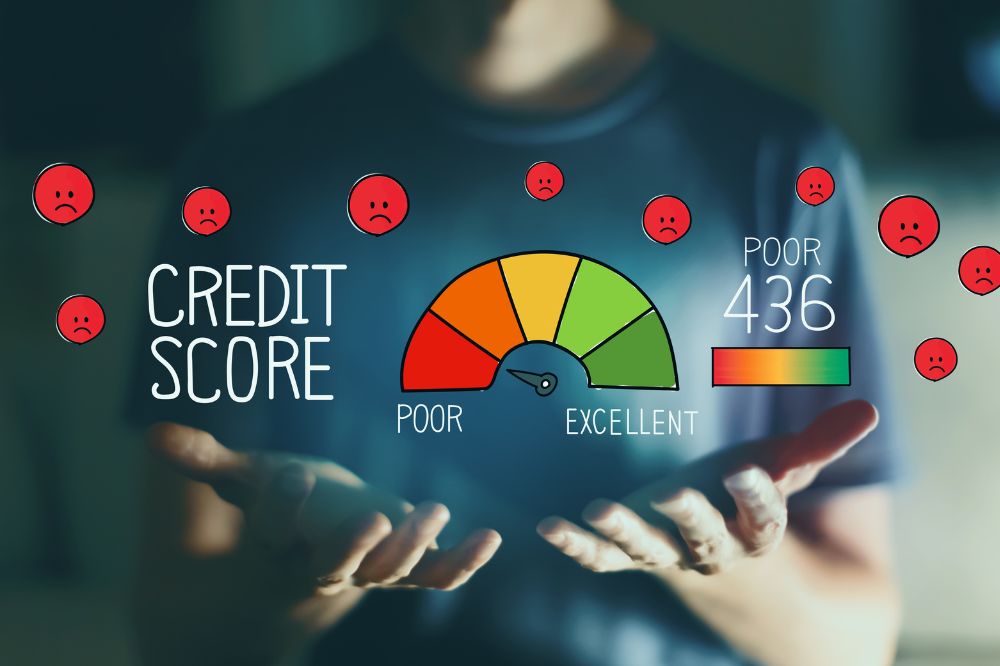Struggling to bounce back financially after bankruptcy? Wondering how to rebuild your credit and regain financial stability? In this guide, we’ll explore practical steps and expert tips on how to effectively rebuild your credit score post-bankruptcy. From establishing a solid budget to understanding credit utilization, payments, savings, financial products, and account, we’ve got you covered. Ready to take control of your financial future, account for money, payments, and embark on a journey towards better credit health?
Key Takeaways
- Take Action: Start by understanding the impact of bankruptcy, then focus on immediate steps post-bankruptcy to rebuild credit effectively.
- Strategic Approach: Utilize strategies like responsible credit card usage and timely payments to improve your credit score gradually.
- Explore Options: Consider alternative credit-building methods such as secured credit cards or credit builder loans to establish a positive credit history.
- Stay Proactive: Maintain financial health by budgeting wisely, saving regularly, and avoiding unnecessary debt to prevent future financial challenges.
- Track Progress: Regularly monitor your credit report and scores to track improvements and address any discrepancies promptly.
- Set Goals: Establish long-term credit goals to stay motivated and focused on achieving financial stability and a strong credit profile.
Understanding Bankruptcy
Bankruptcy Basics
Bankruptcy comprises different types, including Chapter 7 and Chapter 13, each with specific eligibility criteria. Understanding these distinctions is crucial.
Assets such as property and savings may be affected by bankruptcy proceedings. Knowing how this impacts your financial situation is essential for planning ahead.
Certain debts can be discharged through bankruptcy, offering relief to individuals struggling with financial burdens. Learning about dischargeable debts can help in understanding the scope of debt relief available.
Impact on Credit
Bankruptcy typically results in a significant drop in credit score due to the negative impact on financial history. Analyzing this credit score decline is important for assessing the extent of the damage.
Credit reports undergo changes post-bankruptcy, reflecting the discharged debts and overall financial status. Recognizing these alterations helps in monitoring credit health effectively.
Rebuilding credit after bankruptcy becomes a necessity to regain financial stability and access to credit facilities. Understanding the importance of this process is crucial for future financial well-being.

Timeframe for Recovery
Setting realistic expectations regarding credit recovery post-bankruptcy is vital. Identifying achievable goals and milestones helps in staying motivated throughout the process.
Gradual signs of improvement in credit, such as increased credit limits or reduced interest rates, indicate progress towards recovery. Acknowledging these positive changes boosts confidence and encourages continued efforts.
Patience is key when it comes to rebuilding credit after bankruptcy, as it is a gradual process that requires time and consistent financial management. Acknowledge that perseverance and discipline are essential for long-term credit improvement.
Initial Steps Post-Bankruptcy
Credit Report Check
After filing for bankruptcy, it’s crucial to start by reviewing your credit report thoroughly. Look for any inaccuracies or discrepancies that may be negatively impacting your credit score. By identifying and addressing these errors, you can dispute them with the credit bureaus to ensure your report reflects accurate information.
Monitor Credit Score
To begin rebuilding your credit after bankruptcy, track changes in your credit score regularly. Utilize free credit monitoring tools available online to keep a close eye on any fluctuations. By staying updated on your credit status, you can monitor progress and identify areas for improvement as you work towards restoring your financial health.
Strategies for Rebuilding Credit
Keep Balances Low
Maintaining low credit card balances is crucial for rebuilding credit after bankruptcy. By avoiding maxing out credit limits, you demonstrate responsible financial behavior. Focus on reducing debt-to-credit ratio to improve your credit score gradually.
Secured Card Application
Choosing a Card
- Select secured credit cards to start rebuilding your credit.
- Consider applying for credit builder loans to establish a positive payment history.
- Explore various credit options for bad credit individuals offered by reputable financial institutions.
Usage Tips
Using credit responsibly is key to rebuilding your credit post-bankruptcy. Make sure to make timely payments on all accounts to show reliability. Avoid unnecessary spending that could lead to accumulating more debt.
Credit-Builder Loans
Finding Lenders
When seeking credit-builder loans, research lenders specializing in assisting individuals after bankruptcy. Compare interest rates and terms to find the most suitable option. Look for financial institutions that are open to helping with the process of rebuilding credit.
Loan Repayment
Prioritize making timely payments on your credit-builder loans to showcase commitment to improving your credit. If faced with challenges, don’t hesitate to negotiate repayment plans with lenders. Avoid defaulting on loans as it can hinder your progress in rebuilding credit effectively.
Alternative Credit Building Methods
Authorized User Status
Becoming an authorized user on a trusted account is a simple and effective way to rebuild credit. By being associated with someone who has a strong payment history, you can benefit from their positive track record. This association can significantly boost your credit score over time.
Cosigner Advantages
Understanding the responsibilities of having a cosigner is crucial. A cosigner agrees to pay off the debt if the primary borrower defaults, making it a serious commitment. However, having a cosigner can offer immense advantages when applying for credit. Lenders are more likely to approve your applications with a cosigner’s support. Moreover, you can leverage their good credit history for better loan terms.
Maintaining Financial Health
Budgeting Basics
Creating a detailed budget plan is crucial for rebuilding credit after bankruptcy. Start by listing all sources of income and monthly expenses. Allocate specific amounts for necessities like rent, utilities, and groceries. Set aside funds for debt repayment to gradually reduce outstanding balances.
Track your expenses and income diligently to ensure you stay within your budget limits. Use tools like budgeting apps or spreadsheets to monitor your spending habits. Adjust your budget as needed to accommodate unexpected expenses or changes in income. By maintaining a strict budget, you can effectively manage your finances and work towards improving your credit score.
Debt Management
Developing a debt repayment strategy is essential for rebuilding credit post-bankruptcy. Prioritize paying off high-interest debts first to minimize interest charges. Consider debt consolidation options such as personal loans or balance transfer credit cards to streamline multiple debts into one manageable payment.
Negotiate with creditors for better terms on existing debts, such as lower interest rates or extended repayment periods. Communicate openly with lenders about your financial situation and demonstrate your commitment to repaying the debts. By negotiating favorable terms, you can ease the burden of debt repayment and make progress towards rebuilding your credit score.

Monitoring Progress
Regular Credit Checks
To track your credit rebuilding journey effectively, it’s crucial to schedule periodic credit check-ups. By regularly reviewing your credit report, you can monitor any changes or discrepancies that may impact your progress. Stay proactive in identifying and addressing any errors promptly.
Keep a close eye on your credit report for any sudden drops or spikes in your score. These fluctuations can indicate potential issues that need attention. Monitoring your credit report allows you to stay informed about the state of your finances and take necessary steps to maintain or improve your credit standing.
Protect yourself from identity theft by staying vigilant when reviewing your credit report. Look out for any unfamiliar accounts, inquiries, or transactions that could signal fraudulent activity. By tracking these red flags early on, you can prevent further damage to your credit history.
Score Improvement Signs
Recognize the positive indicators of an increasing credit score as you continue to rebuild after bankruptcy. Small improvements, such as a higher credit limit or a lower interest rate, are key signs of progress. Celebrate these victories as they demonstrate your commitment to financial recovery.
Don’t underestimate the power of small wins in the journey towards better credit. Each step forward, no matter how minor, contributes to the overall improvement of your financial health. Acknowledge and celebrate these achievements to motivate yourself to keep pushing forward.
Maintain a positive mindset by focusing on the progress you’ve made so far. Whether it’s paying off a debt or successfully disputing an error on your credit report, every positive action counts towards rebuilding your credit. Use these successes as fuel to drive you towards even greater accomplishments.
Long-Term Credit Goals
Establishing Good Habits
To rebuild your credit after bankruptcy, focus on cultivating responsible financial behaviors. Make timely payments and keep balances low.
Building a strong credit history is crucial. Apply for a secured credit card to demonstrate responsible credit usage.
Fostering long-term financial stability involves creating a budget and sticking to it. Avoid unnecessary expenses to rebuild your credit effectively.
Future Financial Planning
After bankruptcy, set financial goals to work towards. Start with small achievable targets and gradually increase them over time.
Creating a savings plan is essential for emergencies and future investments. Save a portion of your income regularly to build a financial cushion.
Investing in financial literacy education can enhance your understanding of managing money effectively post-bankruptcy.
Common Pitfalls to Avoid
High Interest Traps
Credit rebuilding after bankruptcy can be tricky, especially with high-interest traps lurking. Predatory lending schemes prey on vulnerable individuals, often post-bankruptcy. Always scrutinize interest rates to prevent falling into these traps. Research thoroughly before committing to any loans or credit cards.
Excessive Credit Applications
Post-bankruptcy, it’s crucial to tread carefully with credit applications. Limit the number of applications to avoid risking your credit score further. Multiple hard inquiries can signal desperation to lenders, impacting your creditworthiness negatively. Be discerning and selective when considering new credit opportunities.
Success Stories
Real-Life Examples
Learn from successful credit rebuilders who have navigated the challenging path of rebuilding credit post-bankruptcy. These individuals showcase that with dedication and discipline, positive changes are achievable. By making timely payments and managing finances responsibly, they gradually improved their credit scores.
Understand practical strategies used by these individuals to regain financial stability. By setting a budget, prioritizing debt repayment, and monitoring their credit reports regularly, they took proactive steps towards rebuilding their credit. They also diversified their credit mix by making small purchases and paying off balances promptly.
Gain inspiration from overcoming adversity by witnessing how these individuals transformed their financial situations. Despite facing bankruptcy, they remained resilient and committed to improving their creditworthiness. Their stories serve as a reminder that with determination and perseverance, anyone can bounce back from financial setbacks.
Motivation and Lessons Learned
Stay positive throughout the credit repair journey by focusing on the progress made rather than dwelling on past mistakes. Celebrate each milestone achieved, whether it’s paying off a debt or seeing an increase in your credit score. Maintaining a positive mindset is crucial in staying motivated during this process.
Embrace setbacks as learning opportunities to refine your approach to credit rebuilding. If a payment is missed or a credit application is denied, use these experiences to identify areas for improvement. Adjust your strategies accordingly and continue moving forward towards your goal of rebuilding your credit.
Share experiences to inspire others who may be going through similar challenges. By discussing your journey openly, you can provide valuable insights and encouragement to those seeking to improve their financial health. Your story could motivate someone else to take the first step towards financial recovery.
Closing Thoughts
You’ve learned the ins and outs of rebuilding your credit after bankruptcy. By implementing the strategies discussed, you’re on the right track to improving your financial health. Remember, consistency is key. Monitor your progress regularly, avoid common pitfalls, and set achievable long-term credit goals.
Success stories show that with dedication and smart financial choices, you can rebuild your credit score and secure a brighter financial future. So, take charge of your finances today, start implementing these tips, and watch your credit score soar. Your journey to financial recovery begins now!
Frequently Asked Questions
How does bankruptcy impact my credit score?
Bankruptcy can significantly lower your credit score, making it harder to qualify for loans or credit cards. It stays on your credit report for several years, but you can start rebuilding your credit gradually.
What are the initial steps to take after bankruptcy?
After bankruptcy, review your credit reports for accuracy, create a budget to manage finances better, establish an emergency fund, and consider secured credit cards or credit-builder loans to start rebuilding credit.
Are there alternative methods to build credit after bankruptcy?
Yes, you can explore options like becoming an authorized user on someone else’s credit card, using a co-signer for a loan, or applying for a secured credit card to demonstrate responsible financial behavior.
How can I monitor my progress in rebuilding my credit?
Regularly check your credit reports from all three major bureaus, track your credit score changes over time, review your payment history and utilization ratio, and stay disciplined with your financial habits.
What are common pitfalls to avoid when rebuilding credit post-bankruptcy?
Avoid taking on too much debt too quickly, missing payments or making late payments, neglecting to create a budget and emergency fund, falling for predatory lending offers, and failing to address any errors on your credit report.




